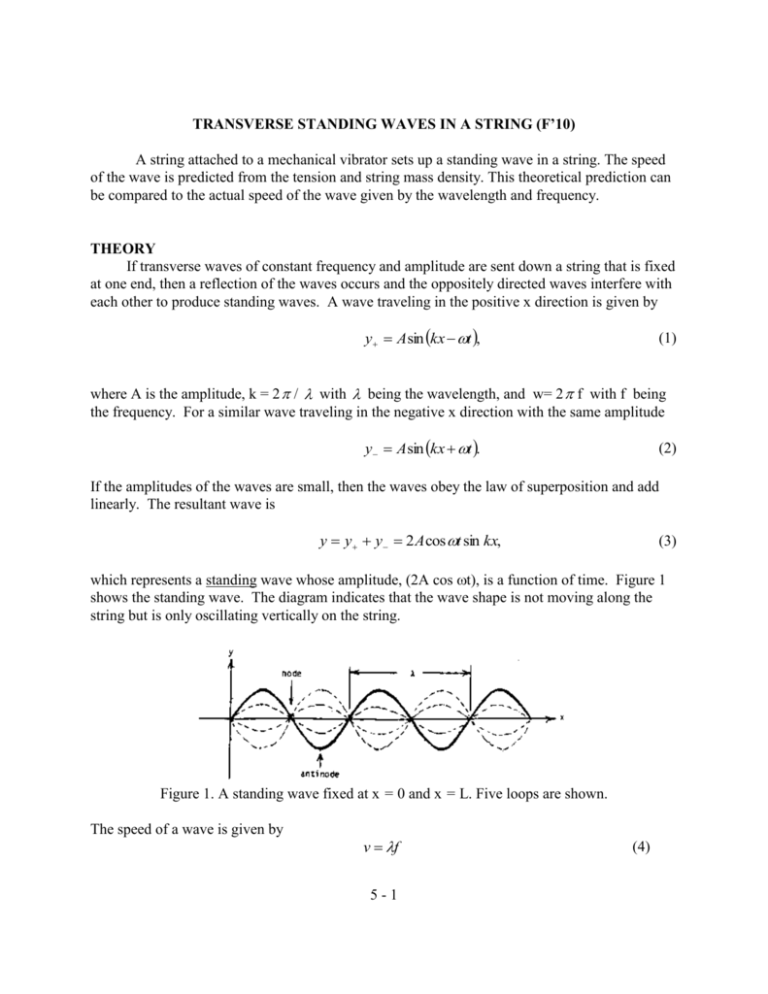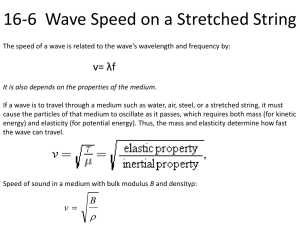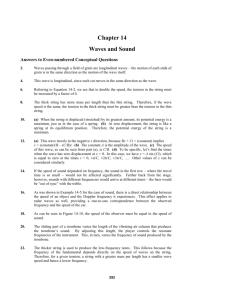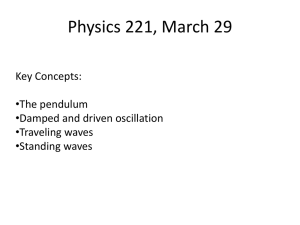Transverse Standing Waves
advertisement

TRANSVERSE STANDING WAVES IN A STRING (F’10) A string attached to a mechanical vibrator sets up a standing wave in a string. The speed of the wave is predicted from the tension and string mass density. This theoretical prediction can be compared to the actual speed of the wave given by the wavelength and frequency. THEORY If transverse waves of constant frequency and amplitude are sent down a string that is fixed at one end, then a reflection of the waves occurs and the oppositely directed waves interfere with each other to produce standing waves. A wave traveling in the positive x direction is given by y A sin kx t , (1) where A is the amplitude, k = 2 / with being the wavelength, and w= 2 f with f being the frequency. For a similar wave traveling in the negative x direction with the same amplitude y A sin kx t . (2) If the amplitudes of the waves are small, then the waves obey the law of superposition and add linearly. The resultant wave is y y y 2 A cos t sin kx, (3) which represents a standing wave whose amplitude, (2A cos t), is a function of time. Figure 1 shows the standing wave. The diagram indicates that the wave shape is not moving along the string but is only oscillating vertically on the string. Figure 1. A standing wave fixed at x = 0 and x = L. Five loops are shown. The speed of a wave is given by v f 5-1 (4) where f is the frequency and is the wavelength. In addition 2LN N (5) v 2LN f N (6) where LN is the length of N loops. Therefore, In theory, the speed of the wave, in terms of the tension FT, and the mass per unit length of the string is v theo FT (7) here FT = mg, where m is the hanging mass and g is the acceleration due to gravity, so v theo mg (8) In the experiment a string is attached to a mechanical vibrator. The other end of the string passes over a pulley to a weight hanger. (Refer to Figure 2.) The vibrator sets up standing waves on the string and the amplitude of these waves can then be maximized by changing the weight on the weight hanger or by moving the vibrator toward or away from the pulley. Figure 2. The apparatus set up with standing waves on the string. APPARATUS 0 0 0 mechanical vibrator Pasco function generator 2 leads 0 0 0 weight hanger (50 g) slotted weights (±0.2g) string, 2.5 meters long 5-2 0 0 table clamps and upright rod-mounted pulley 0 0 2 meter long meter stick strobe light (±1 %) PROCEDURE a) Record the mass per unit length of the string, µ and its uncertainty, . b) Set up the apparatus as shown in Figure 2 with a total of 100 grams hanging from the end of the string. Remember the hanger is 50 g. Connect the power supply to the vibrator with the two leads, and plug in the frequency generator. Record the total mass hanging from the end of the string. c) Turn up the frequency slowly until you see two clear nodes (not counting the ones at the ends). Measure the length of the loop between the nodes (LN ) and estimate its uncertainty (L). This uncertainty estimate should reflect the fact that the positions of the nodes are difficult to resolve. d) Increase the frequency until you see three clear nodes. Measure the length of the two loops in the middle. Repeat procedure with three loops in the middle. e) Change the mass hanging from the end of the string to 150 grams and repeat the entire procedure above. Change to 200 grams and repeat again. f) If time permits, use the strobe light to verify one of frequencies of the vibrator. Set up the strobe light so that it illuminates the vibrating string. Turn on the strobe and find the highest frequency that will produce one image. The dial on the strobe gives the frequency in flashes per minute and has an accuracy of 1 %. ANALYSIS Calculate the experimental values of the wave speed and the theoretical value of the wave speed for each hanging mass. Include the corresponding uncertainties, v. Show a sample of your calculations. Report these values together in a results table and determine the percent difference between the experimental and theoretical values. Also graph these values on onedimensional graph using error bars. Offset the values vertically from one another. The uncertainty in the speed values can be found using the fractional uncertainty method, L f (9) v = v L f and, 5-3 m vtheo = vtheo 2m 2 (10) where the hanging mass m, has an uncertainty of ±0.2grams. A good results table would look like this: String Tension (N) vtheo ± vtheo (m/s) Frequency (Hz) v ± v (m/s) % difference F1= F2= F3= The one-dimensional error bar-graph should be drawn below the results table. QUESTIONS 1. Show that (3) is the result of adding (1) and (2). This is also a homework problem. 2. Explain why = 2LN/N, where LN is the length of N loops. 3. Does the frequency affect the wave speed? Should it? Explain. 4. Would you say that your results validate the theoretical formula for the wave speed in strings? Justify your answer. 5. Give a conceptual explanation of why increasing the tension should increase the wave speed, whereas increasing mass density should decrease the wave speed. 6. In the calculation of the theoretical speed (7), the mass associated with the length of the string hanging over the pulley was not taken into account. Suppose that the length of the string hanging over the pulley is 20 cm and that the hanging mass is 100 grams. What percentage error in the theoretical speed value arises from ignoring the hanging string mass in this case? Were we justified in ignoring the hanging string mass in our calculations? 5-4 5-5








